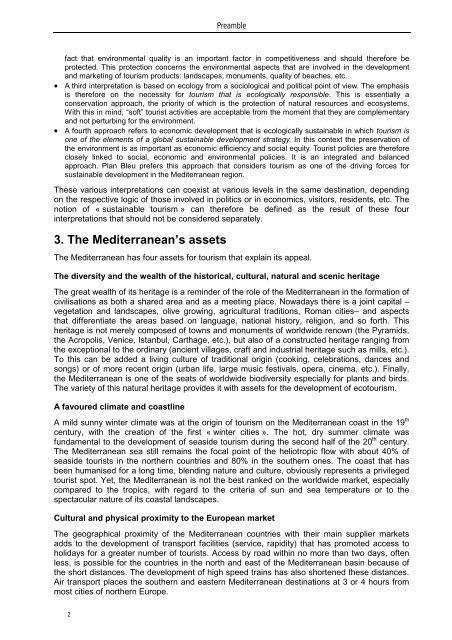dossier sur le tourisme et le développement durable
dossier sur le tourisme et le développement durable
dossier sur le tourisme et le développement durable
Create successful ePaper yourself
Turn your PDF publications into a flip-book with our unique Google optimized e-Paper software.
2<br />
Preamb<strong>le</strong><br />
fact that environmental quality is an important factor in comp<strong>et</strong>itiveness and should therefore be<br />
protected. This protection concerns the environmental aspects that are involved in the development<br />
and mark<strong>et</strong>ing of tourism products: landscapes, monuments, quality of beaches, <strong>et</strong>c.<br />
• A third interpr<strong>et</strong>ation is based on ecology from a sociological and political point of view. The emphasis<br />
is therefore on the necessity for tourism that is ecologically responsib<strong>le</strong>. This is essentially a<br />
conservation approach, the priority of which is the protection of natural resources and ecosystems.<br />
With this in mind, “soft” tourist activities are acceptab<strong>le</strong> from the moment that they are comp<strong>le</strong>mentary<br />
and not perturbing for the environment.<br />
• A fourth approach refers to economic development that is ecologically sustainab<strong>le</strong> in which tourism is<br />
one of the e<strong>le</strong>ments of a global sustainab<strong>le</strong> development strategy. In this context the preservation of<br />
the environment is as important as economic efficiency and social equity. Tourist policies are therefore<br />
closely linked to social, economic and environmental policies. It is an integrated and balanced<br />
approach. Plan B<strong>le</strong>u prefers this approach that considers tourism as one of the driving forces for<br />
sustainab<strong>le</strong> development in the Mediterranean region.<br />
These various interpr<strong>et</strong>ations can coexist at various <strong>le</strong>vels in the same destination, depending<br />
on the respective logic of those involved in politics or in economics, visitors, residents, <strong>et</strong>c. The<br />
notion of « sustainab<strong>le</strong> tourism » can therefore be defined as the result of these four<br />
interpr<strong>et</strong>ations that should not be considered separately.<br />
3. The Mediterranean’s ass<strong>et</strong>s<br />
The Mediterranean has four ass<strong>et</strong>s for tourism that explain its appeal.<br />
The diversity and the wealth of the historical, cultural, natural and scenic heritage<br />
The great wealth of its heritage is a reminder of the ro<strong>le</strong> of the Mediterranean in the formation of<br />
civilisations as both a shared area and as a me<strong>et</strong>ing place. Nowadays there is a joint capital –<br />
veg<strong>et</strong>ation and landscapes, olive growing, agricultural traditions, Roman cities– and aspects<br />
that differentiate the areas based on language, national history, religion, and so forth. This<br />
heritage is not merely composed of towns and monuments of worldwide renown (the Pyramids,<br />
the Acropolis, Venice, Istanbul, Carthage, <strong>et</strong>c.), but also of a constructed heritage ranging from<br />
the exceptional to the ordinary (ancient villages, craft and industrial heritage such as mills, <strong>et</strong>c.).<br />
To this can be added a living culture of traditional origin (cooking, ce<strong>le</strong>brations, dances and<br />
songs) or of more recent origin (urban life, large music festivals, opera, cinema, <strong>et</strong>c.). Finally,<br />
the Mediterranean is one of the seats of worldwide biodiversity especially for plants and birds.<br />
The vari<strong>et</strong>y of this natural heritage provides it with ass<strong>et</strong>s for the development of ecotourism.<br />
A favoured climate and coastline<br />
A mild sunny winter climate was at the origin of tourism on the Mediterranean coast in the 19 th<br />
century, with the creation of the first « winter cities ». The hot, dry summer climate was<br />
fundamental to the development of seaside tourism during the second half of the 20 th century.<br />
The Mediterranean sea still remains the focal point of the heliotropic flow with about 40% of<br />
seaside tourists in the northern countries and 80% in the southern ones. The coast that has<br />
been humanised for a long time, b<strong>le</strong>nding nature and culture, obviously represents a privi<strong>le</strong>ged<br />
tourist spot. Y<strong>et</strong>, the Mediterranean is not the best ranked on the worldwide mark<strong>et</strong>, especially<br />
compared to the tropics, with regard to the criteria of sun and sea temperature or to the<br />
spectacular nature of its coastal landscapes.<br />
Cultural and physical proximity to the European mark<strong>et</strong><br />
The geographical proximity of the Mediterranean countries with their main supplier mark<strong>et</strong>s<br />
adds to the development of transport facilities (service, rapidity) that has promoted access to<br />
holidays for a greater number of tourists. Access by road within no more than two days, often<br />
<strong>le</strong>ss, is possib<strong>le</strong> for the countries in the north and east of the Mediterranean basin because of<br />
the short distances. The development of high speed trains has also shortened these distances.<br />
Air transport places the southern and eastern Mediterranean destinations at 3 or 4 hours from<br />
most cities of northern Europe.
















